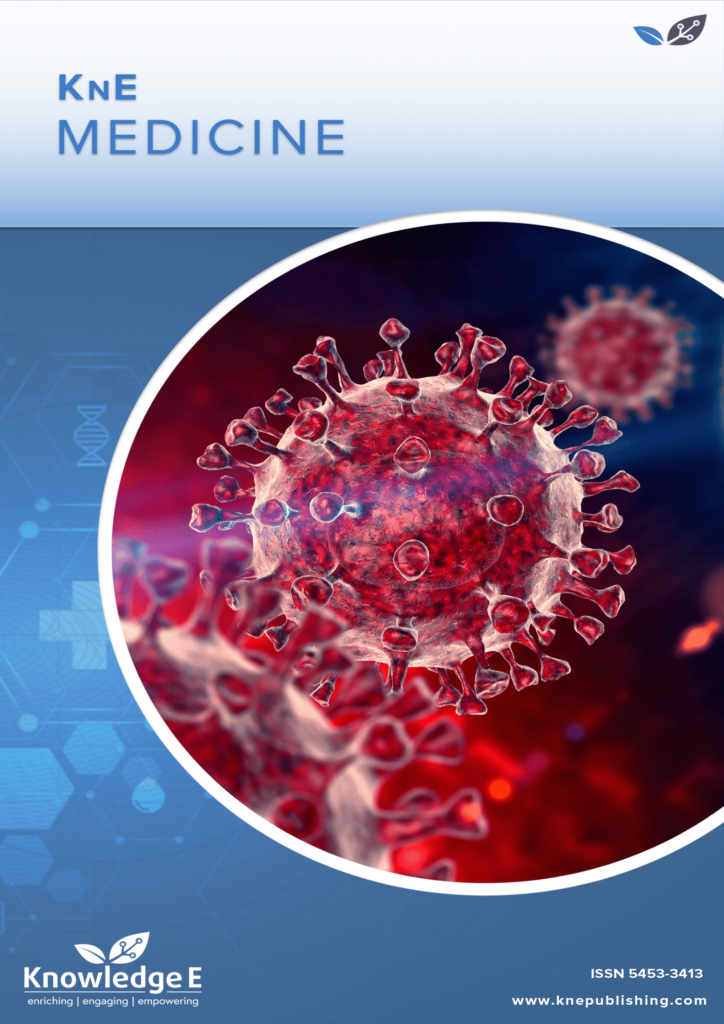
KnE Medicine
ISSN: 2519-125X
The latest conference proceedings on all fields of medicine.
Development of Liposomal Dry Powder Inhalation to Increase the Effectiveness of Tuberculosis Therapy
Published date: Sep 15 2022
Journal Title: KnE Medicine
Issue title: The International Conference of Medicine and Health (ICMEDH)
Pages: 671–676
Authors:
Abstract:
Tuberculosis (TB) is one of the most threatening infectious diseases for Indonesian people. The number of TB patients in 2020 was estimated at 845,000 people with 98,000 deaths. One of the factors that causes difficulty in TB therapy is the lack of adherence and the slow development of new antibiotics when antibiotic resistance appears. The development of nanotechnology-based preparation has the potential to increase the therapeutic effectiveness of the active ingredients, such as in the dry powder inhaler form, which allows the active ingredients to be delivered efficiently to the lungs as the target organs.
Keywords: tuberculosis, liposomes, antibiotics, dry powder inhalation
References:
[1] Pham D-D, Fattal E, Tsapis N. Pulmonary drug delivery systems for tuberculosis treatment. International Journal of Pharmaceutics. 2015;478(2)517–529.
[2] CDC | TB | Data and Statistics. Available from: https://www.cdc.gov/tb/statistics/
[3] Meng Y, Hou X, Lei J, et al. Multi-functional liposomes enhancing target and antibacterial immunity for antimicrobial and anti-biofilm against methicillin-resistant Staphylococcus aureus. Pharmaceutical Research. 2016;33(3):763–775.
[4] Huh AJ, Kwon YJ. Nanoantibiotics: A new paradigm for treating infectious diseases using nanomaterials in the antibiotics resistant era. Journal of Controlled Release. 2011;156(2):128–145.
[5] Hillery AM, Lloyd AW, Swarbrick J, editors. Drug delivery and targeting for pharmacists and pharmaceutical scientists. London, UK: Taylor & Francis; 2001.
[6] Chimote G, Banerjee R. In vitro evaluation of inhalable isoniazid-loaded surfactant liposomes as an adjunct therapy in pulmonary tuberculosis. Journal of Biomedical Materials Research. Part B, Applied Biomaterials. 2010;94(1)1–10.
[7] Park JH, Oh N. Endocytosis and exocytosis of nanoparticles in mammalian cells. International Journal of Nanomedicine. 2014:51.
[8] Chibowski E, Szcześ A. Zeta potential and surface charge of DPPC and DOPC liposomes in the presence of PLC enzyme. Adsorption. 2016;22(4–6):755–765.
[9] Sobral CNC, Soto MA, Carmona-Ribeiro AM. Characterization of DODAB/DPPC vesicles. Chemistry and Physics of Lipids. 2008;152(1):38–45.
[10] Çağdaş M, Sezer AD, Bucak S. Liposomes as potential drug carrier systems for drug delivery. In: Sezer AD, editor. Application of nanotechnology in drug delivery. InTech; 2014.
[11] Maherani B, Arab-Tehrany E, Mozafari MR, Gaiani C, Linder M. Liposomes: A review of manufacturing techniques and targeting strategies. Current Nanoscience. 2011;7(3):436–452.
[12] Shah SP, Misra A. Liposomal amikacin dry powder inhaler: Effect of fines on in vitro performance. AAPS PharmSciTech. 2004;5(4):107–113.